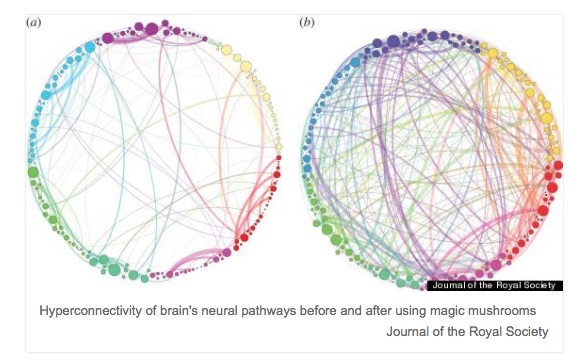As a psychotherapist who has worked with trauma victims and cancer patients, I would like to share my thoughts on “why” psychedelic-assisted psychotherapy is proving to be highly effective as a healing modality.
Psilocybin — or magic mushrooms — have been used in traditional healing rituals for thousands of years. However, for more than 40 years it has been illegal in the U.S.
But recent findings are tearing down the barriers surrounding psychedelic research, as it has been clinically shown that they have the ability to ease depression and soothe anxiety in patients dealing with serious illness and impending death. Two separate studies, one at New York University and one at Johns Hopkins University, discovered that a single, moderate-to-large dose of psilocybin was able to help alleviate profound distress among cancer patients.
Lifting the Taboo on Psychedelic Research
Harvard psychology professor Timothy Leary infamously sparked an aggressive promotion of LSD in the 1960s that would ultimately lead to the loss of his teaching position and a federal ban, the Controlled Substance Act of 1970, on all research on psychedelics.
This research blackout came to an end in 1999, when Roland R. Griffiths, Ph.D., of Johns Hopkins initiated a new series of studies on psilocybin. He has since become known as the “grandfather of the psychedelic renaissance” and a 21st-century pioneer in the field. Unlike Leary, however, he does not aspire to be a guru or shaman. Rather, as a clinical pharmacologist and author of over 300 studies on mood-altering substances, Griffiths prefers the path of scientific caution.
Griffiths claims his initial interest with psychedelics came from his own mindfulness meditation practice. His interest was further sparked when he administered psilocybin to volunteers and found that two-thirds of the participants called their psychedelic journey among the most significant experiences of their lives.
Today, Griffiths touts the use of psychedelic-assisted psychotherapy for its ability to treat a variety of debilitating conditions, such as depression in terminally ill patients, post-traumatic stress syndrome among war vets, and alcohol and tobacco dependence.
Griffiths says: “There is something about the core of this experience that opens people up to the great mystery of what it is that we don’t know. It is not that everybody comes out of it and says, ‘Oh, now I believe in life after death.’ That needn’t be the case at all. But the psilocybin experience enables a sense of deeper meaning, and an understanding that in the largest frame everything is fine and that there is nothing to be fearful of. There is a buoyancy that comes of that which is quite remarkable”
“To see people who are so beaten down by cancer, and they start actually providing reassurance to the people who love them most, telling them ‘it is all okay and there is no need to worry’— when a dying person can provide that type of clarity for their caretakers, even we researchers are left with a sense of wonder.”
Why Psychedelic-Assisted Psychotherapy Is So Effective?
Researchers know “how,” but they do not know “why” psilocybin has worked in these settings. One theory is that psilocybin interrupts the circuitry of self-absorbed thinking that is so pronounced in depressed people, making way for new ways of thinking and even for a mystical experience.
Dr. Robin Carhart-Harris’s group at Imperial College in London is doing neuro-imaging studies. These studies suggest that the positive effects of psychedelic-assisted psychotherapy are explained by changes in something in the brain called “the default mode network.”
It turns out that this network is hyperactive in depression. Interestingly, in both meditation and also with psilocybin this network becomes quiescent. This may correlate with the experience of clarity, of coming into the present moment, which is the key to getting out of self-absorbing thinking and to experiencing feelings of inter-connectedness.

Normally, information is exchanged in the brain using various circuits, or what one researcher describes as “informational highways.” On some highways, there’s a steady stream of traffic. On others, however, there are rarely more than a few cars on the road. Psychedelics appear to drive traffic to these underused highways, opening up dozens of different routes and freeing up some space along the more heavily used ones ̶ thereby facilitating an expanded sense of awareness and access to new perspectives among participants in psychedelic therapy sessions.
Moment of Absolute Clarity
My theory on “why” psychedelic-assisted psychotherapy works correlates closely with the findings of these brain imaging studies. What we are seeing here are neural representations of major shifts in awareness. When you have a mind-expanding experience, you can transition from fear and anxiety to confident self-empowerment. This, in turn, provides a serene sense of well-being that is essential to both emotional and physical healing.
In this context, we can begin to understand how psychedelic-assisted psychotherapy can provide fast and effective treatment for a variety of patients suffering from addiction, depression and trauma. By “fast,” we are referring to positive results coming from one or two sessions, as opposed to the months and even years that traditional psychotherapy requires.
In contrast, Dr. Stephen Ross, the lead investigator and chief of addiction psychiatry at N.Y.U., points out that antidepressants can take weeks to show benefit. “Cancer patients with anxiety and depression need help immediately,” he said, “especially if you consider that they are at elevated risk for completed suicide.”
In conclusion: the moment of absolute clarity is the treasure that psychedelics hold!
Julie M. Brown, M.A., LMHC, is an integral psychotherapist and coauthor of The Psychedelic Gospels: The Secret History of Hallucinogens in Christianity.







